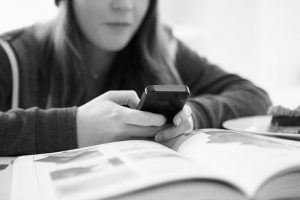Is it time to break up with your phone?
An analyis of Catherine Price’s book: “How To Break Up With Your Phone” and how it connects to phone usage for OPRF students.

OPRF junior Maggie Blonski is spending time the way many teens do: on TikTok. She scrolls, watching video after video.
And then she wakes up.
Like 800 million users around the world, Blonski watches TikTok videos, and she is hooked. She admitted she occasionally dreams about scrolling through the stream of videos on her “For You Page.” Last week, she spent nearly 14 hours on TikTok. If she keeps this pattern, she will have spent two and a half full days on the app over a month.
Most teenagers are aware something is up with their phones. Whether a teacher has told them that social media correlates to depression or they have pulled an all-nighter watching YouTube, teenagers are not blind to the fact that smartphones are dramatically changing the way humans live. Some can even tell that it changes the way their own brain function.
When asked whether her phone affects her brain, another OPRF junior responded, “Yeah. I don’t know how it does, but I know it does.” But she said she feels she can handle her phone without “going too far.”
In her book, “How To Break Up With Your Phone,” science journalist Catherine Price says smartphone engineers work to maximize the attention we give to our phones. “…designers manipulate our brain chemistry in ways that are known to trigger addictive behaviors.”
Price explains the use of our phones releases dopamine: a chemical that makes us excited, and when our brains associate our phones with a reward, we crave notifications and likes and snaps, and check our phones even there is not anything new.
“We become like the lab rats,” Price says, “constantly pressing the lever to get food.”
“They’re doing a great job” at addicting us, said student Kristina Landes.
It is not a lack of willpower making the hours seemingly disappear when we use our phones. In an email conversation, Price says, “Our brains are constantly changing in response to the stimuli to which they’re exposed, and that if you do ANYTHING for four hours a day, it’s going to change your brain…In the case of TikTok and most things on our phones, we’re training our brains to expect and crave constant hits of dopamine.”
Olivia Lonergan could also see the connection between TikTok and dopamine. TikTok “has such a good (algorithm)…it just keeps you going and swiping and swiping and swiping ’cause it’s never ending. If you’re on your For You Page, you can keep going forever.”
In the first half of her book, Price explores how smartphones affect our brains and thoughts. “We’re shortening our attention spans and eroding our ability to remember things. We’re not learning much or developing new skills…There are very few things that I do on my phone that have a positive effect on my brain.” She says there are some obvious exceptions, like apps that help you learn a language.
On our phones, we are constantly distracted and actively deciding what to pay attention to, causing mental fatigue.
“When mental fatigue causes us to give in to our brain’s natural preference for distraction — whether we’re falling for clickbait or swiping over to social media — we reinforce the same mental circuits that made it hard to sustain our focus to begin with. We get better at not staying focused.”
Lonergan said her attention span is “awful…zero percent, like, it’s not there. It’s non existent.” Her friends likewise feel that they have short attention spans.
Teacher and member of the OPRF Cell Phone Committee Daniel Wolman said phones have a “look at me” design that is distracting. He referenced studies conducted comparing test scores of students who had phones on their desks and those who did not. The results were “overwhelming,” with the latter group scoring better. “It interferes with learning in a way that is harmful for our students.”
Wolman said the committee was created in 2019 out of “a growing concern…that the pervasive use of cell phones throughout the school day, both in and out of the classroom, was becoming problematic and antithetical to the kind of school culture and climate that we wanted.” This was the year a swastika was Airdropped during an assembly, which was the “last straw.”
Price also says phones can also make people tired. Wolman says his phone “zaps” his energy. Landes says “I think that I’m just more mentally tired” because of her phone.
Phones also reduce creative ideas: “Creativity is often sparked by boredom, which is another mental state that our phones are great at helping us avoid,” writes Price).
On the other hand, there are many positive aspects of our phones.
Blonski says “I watch TikTok because it genuinely makes me happy. There’s so many like-minded people and I do learn a lot about current issues. It also makes me laugh and feel good.”
“If TikTok had been around when I was a teenager, I can guarantee I would have been on it ALL THE TIME since I love making and sharing music videos,” Price says. “…it’s a more positive social media platform than Twitter, Facebook and Instagram in the sense of the type of content being posted and the emotional effects it has on users (I say “at the moment” because many of the other platforms started out more positively, too).”
But do the advantages outweigh the risks? The second half of Price’s book details a 30-day plan for you to “break up” with your phone, or in other words, to minimize the risks that come with this helpful and fun technology. This way, you can choose, among other things, when and for how long you want to use your phone.
Nobody can force you to go through a 30-day plan to reconstruct your relationship with your phone. Price says in her book it’s entirely subjective as to whether you have an unhealthy relationship with your phone and entirely up to you what you do about it.
She never says “if you spend x hours a day on your phone, your brain is rotting.” In fact, she doesn’t tell people they have a problem or believe “finger wagging” is going to help. It is more personal. She encourages readers to examine their phone use by asking themselves how much time they want to spend on certain apps and why that is.
Price says “people who don’t think they’ve got an addictive relationship with their phone try turning it off for 24 hours and taking a total break…During the 24-hour break…notice how often you find yourself craving your phone — chances are, you’re going to experience the tech equivalent of a smoker craving a cigarette.
For apps like TikTok, Price says you should “ask yourself what you like about it, and what ‘dose’ allows you to enjoy it without feeling gross afterwards — and then figure out a plan for how to use it in a way that makes you feel good.”
“If you find it too easy to fall down a rabbit hole, you can always delete the app. “That doesn’t mean you can never use it; it just requires you to reinstall it before you open it. That small ‘speed bump’ can really help you make sure that when you use the app, it’s the result of a conscious choice.”
When it comes to phones in schools, Price says “there should be clearer (and enforced) policies about device-use in school…school is a rare opportunity to actually get to interact with other humans in person, and that devices get in the way of those interactions. And also: you can’t learn or remember anything if you’re distracted, and smartphones are designed to pull you out of the moment and distract you.”
Had OPRF had in-person school this year, the Cell Phone Committee would have introduced a major change in cell phone policy. Last year, teachers could decide what to do with phones in their classrooms. This year, students would have been required to keep their cell phones in their bags, off and out of sight, for the duration of the class period.
Wolman said one change that has come with phones is that “it has given us a belief that we never have to be bored again” (which is both good and bad) and “we’ve lost an ability…to just be.”
Although it might anger students and parents, Wolman said that during the school day, he believes learning really does take priority over family life. Many teens use their phones throughout the day to communicate with friends and family.
However, Wolman says “The idea that we all need to be able to reach our parents and access each other all day long every second of the day, is a myth and is a problem.” If there is something critical, no teacher would refuse to let the student go into the hall to call a parent.
Parents are also a part of this problem.
“Parents need to learn to wait a little bit and to be patient,” said Wolman. “Sometimes the message can wait a couple minutes instead of a couple seconds and nobody will be worse for it.”
The average teenager spends seven hours and 22 minutes per day on a cell phone. Teens (who on average get seven hours of sleep) are spending more time on their phones than sleeping.
“Every minute you’re spending on TikTok is a minute you are not spending on something else,” Price said. “I don’t think there is anything inherently wrong with TikTok, but…what experiences are you not having, and what skills are you not developing, as a result of spending that much time on TikTok?
“Personally, my goal in life is to be as interested and interesting as possible — I want to learn lots of things and have lots of skills — and I’ve realized that the only way to accomplish those things is to prioritize them. If I allow myself to get sucked into my phone for two hours, that’s two hours that I did NOT spend doing something that would bring me true meaning or joy, such as playing music or spending time with someone I love.”
One takeaway from Price’s book is that we have the right to choose how we spend our time, and this isn’t always the case with phones. Some say there isn’t enough evidence to support claims that phones affect our brains. However, the addictive design of smartphones is a proven fact.
Price said, “If I were to take a really tough love approach, I would say this: someday, you’re going to die. It might not seem like it right now, but your time on earth is finite. How much of it do you want to spend on TikTok?”







